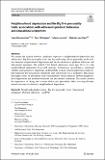Files in this item
Neighbourhood deprivation and the Big Five personality traits : associations with adolescent problem behaviour and educational attainment
Item metadata
| dc.contributor.author | Nieuwenhuis, Jaap | |
| dc.contributor.author | Kleinepier, Tom | |
| dc.contributor.author | Janssen, Heleen | |
| dc.contributor.author | van Ham, Maarten | |
| dc.date.accessioned | 2021-08-04T15:30:07Z | |
| dc.date.available | 2021-08-04T15:30:07Z | |
| dc.date.issued | 2021-08-04 | |
| dc.identifier | 275067747 | |
| dc.identifier | 087d15c7-3bf0-4150-a4d6-9d3718cc444a | |
| dc.identifier | 85111749871 | |
| dc.identifier | 000681241100001 | |
| dc.identifier.citation | Nieuwenhuis , J , Kleinepier , T , Janssen , H & van Ham , M 2021 , ' Neighbourhood deprivation and the Big Five personality traits : associations with adolescent problem behaviour and educational attainment ' , Journal of Housing and the Built Environment , vol. First Online . https://doi.org/10.1007/s10901-021-09876-3 | en |
| dc.identifier.issn | 1566-4910 | |
| dc.identifier.other | ORCID: /0000-0002-2106-0702/work/98196696 | |
| dc.identifier.uri | https://hdl.handle.net/10023/23715 | |
| dc.description | Funding: The UK Medical Research Council and Wellcome (Grant ref: 102215/2/13/2) and the University of Bristol provide core support for ALSPAC. A comprehensive list of grants funding is available on the ALSPAC website. This research was specifically funded by the European Research Council under the European Union's Seventh Framework Programme (FP/2007-2013) / ERC Grant Agreement n. 615159 (ERC Consolidator Grant DEPRIVEDHOODS, Socio-spatial inequality, deprived neighbourhoods, and neighbourhood effects). | en |
| dc.description.abstract | We studied the relation between cumulative exposure to neighbourhood deprivation and adolescents’ Big Five personality traits, and the moderating role of personality in the relation between neighbourhood deprivation and the development of problem behaviour and educational attainment. We studied 5365 British adolescents from ages 10 to 16, with neighbourhood information from birth onwards. Extraversion, agreeableness, emotional stability, and openness to experience moderated the relation between deprivation and problem behaviour. For educational attainment, only extraversion was a moderator. This means that higher values on personality traits were related to weaker relations between neighbourhood deprivation and problem behaviour and educational attainment. The results showed the importance of taking into account adolescents’ personality when assessing developmental outcomes in relation to neighbourhood deprivation. | |
| dc.format.extent | 21 | |
| dc.format.extent | 663440 | |
| dc.language.iso | eng | |
| dc.relation.ispartof | Journal of Housing and the Built Environment | en |
| dc.subject | Neighbourhood deprivation | en |
| dc.subject | Big five personality traits | en |
| dc.subject | Educational attainment | en |
| dc.subject | Problem behaviour | en |
| dc.subject | ALSPAC | en |
| dc.subject | HD Industries. Land use. Labor | en |
| dc.subject | HN Social history and conditions. Social problems. Social reform | en |
| dc.subject | 3rd-DAS | en |
| dc.subject | SDG 15 - Life on Land | en |
| dc.subject.lcc | HD | en |
| dc.subject.lcc | HN | en |
| dc.title | Neighbourhood deprivation and the Big Five personality traits : associations with adolescent problem behaviour and educational attainment | en |
| dc.type | Journal article | en |
| dc.contributor.sponsor | European Research Council | en |
| dc.contributor.institution | University of St Andrews. Population and Health Research | en |
| dc.contributor.institution | University of St Andrews. School of Geography & Sustainable Development | en |
| dc.identifier.doi | 10.1007/s10901-021-09876-3 | |
| dc.description.status | Peer reviewed | en |
| dc.identifier.grantnumber | ERC-2013-CoG | en |
This item appears in the following Collection(s)
Items in the St Andrews Research Repository are protected by copyright, with all rights reserved, unless otherwise indicated.

